
NSW State Seasonal Update - June 2018
NSW continues to experience widespread agronomic drought conditions. As of 30 June, approximately 99% of the state is covered by one of the three drought categories. Up to 40% of the state is Drought Affected, 44% in Drought and 15% in Intense Drought. The seasonal conditions reported in May have further deteriorated, particularly in the north of the state and the vast majority of the agricultural production zones continues to be in mild to severe drought. This continues the drought event that has persisted in some regions since October 2017.
There are regions in the south east and south central of the state that did receive rainfall in June and these have provided late sowing opportunities as well as some pasture growth. These conditions do not constitute a recovery from drought and the areas remain Drought Affected. A large rainfall event occurred in the north west of the state, centred on Brewarrina in late June, and while this has provided some relief it does not constitute a sustained recovery from drought, and this region remains in the Drought category.
The Northern Tablelands and eastern parts of North West Local Land Services (LLS) have seen a decline in conditions during June, with the majority of these regions in the Drought or Intense Drought categories. The far northern parts of North Coast LLS region has also seen a decline in conditions as it transitioned from Non-Drought to Drought Affected during June. The Drought Direction Index remains strongly negative in this region highlighting continuing deterioration of conditions.
The Combined Drought Indicator (CDI) establishes that a number of regions are currently experiencing the most severe category of Intense Drought. This includes parts of Western, Central West, Central Tablelands, North West, Northern Tablelands, Hunter, Greater Sydney and South East Local Land Services regions. This means that these regions are experiencing a more acute rainfall deficit, although it is important to recognise that poor agronomic conditions are being experienced across a much wider area of the state.
The area of Drought continues to expand, and covers large parts of Western, North West, Northern Tablelands, Hunter, Central West, Central Tablelands, Riverina and South East LLS regions.
The latest climate forecasts highlight increased likelihood of the warm dry conditions continuing for much of NSW. Australian and international forecasting services have also placed the region on an El Niño Watch, with a 50% chance of an El Niño developing in spring 2018. El Niño conditions are associated with below average rainfall in south eastern Australia.
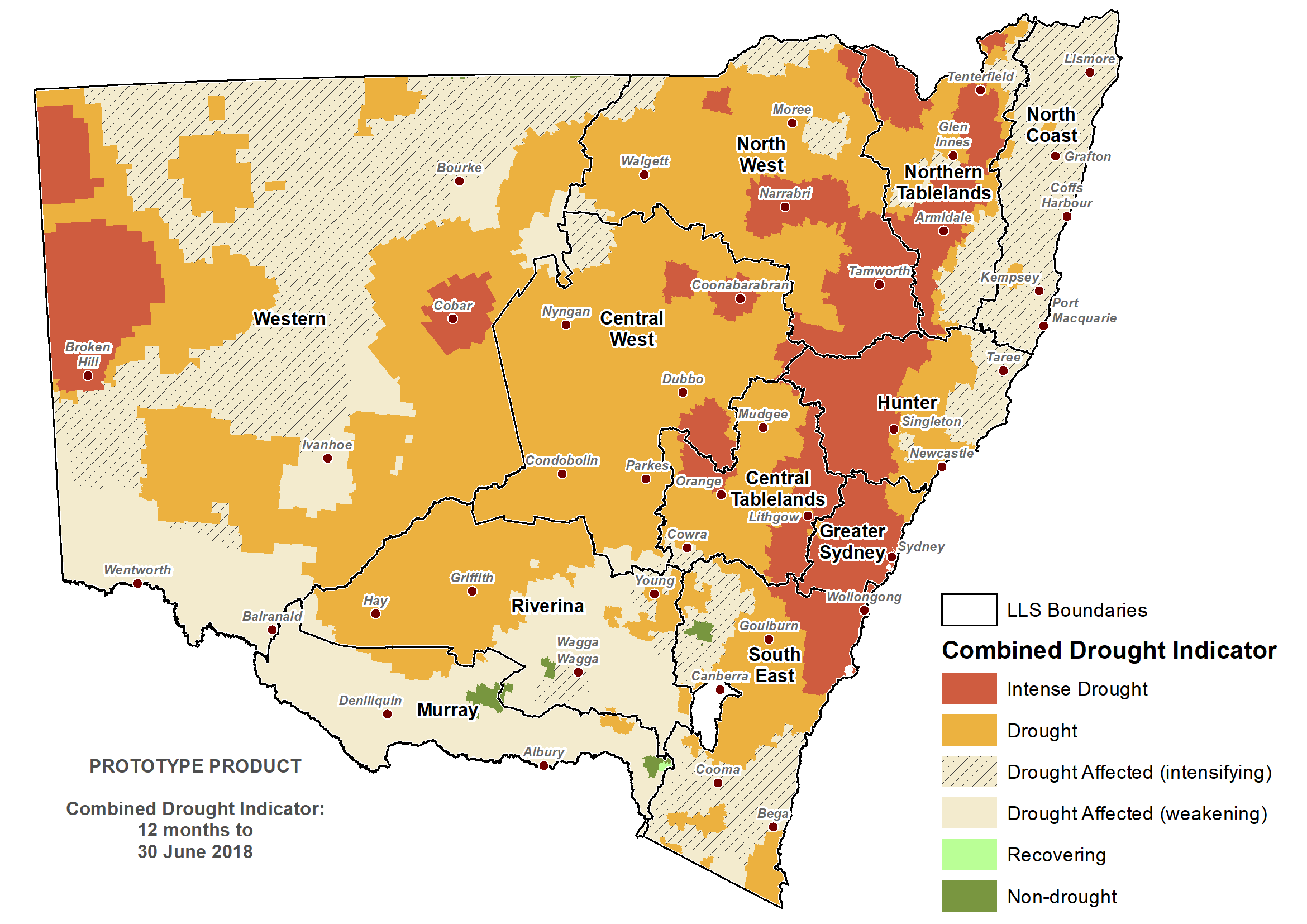
It is important to recognise the CDI provides an aggregated view of the State, and that on-ground conditions can be different to those displayed in the maps. They provide an ‘on average’ view of a particular region only.
Rainfall
Rainfall totals were average to well below average across most of NSW. Above average falls of rain were recorded in parts of the coastal regions of Hunter and eastern parts of Western Local Land Services (LLS) region. Rainfall ranged from 0-50mm across most of NSW, with the highest falls in the coastal regions of Hunter LLS (Figure 2). Large parts of Western, North West and Northern Tablelands received rainfall of less than 10mm. In the south of the state rainfall from 25-50mm was recorded while up to 100mm was recorded in the alpine areas.
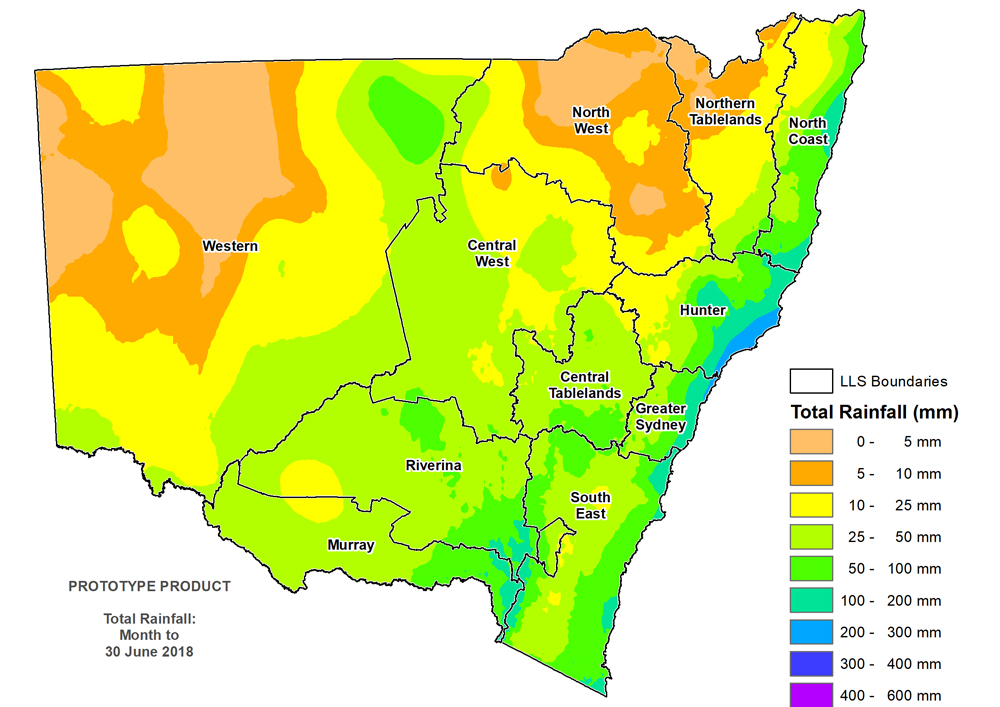
Normalised Difference Vegetation Index (NDVI) Anomaly
The monthly NDVI anomaly (Figure 3) indicates that lower than normal greenness extended across NSW during June. These values are indicative of very poor agronomic conditions where crops and pastures are under significant stress.
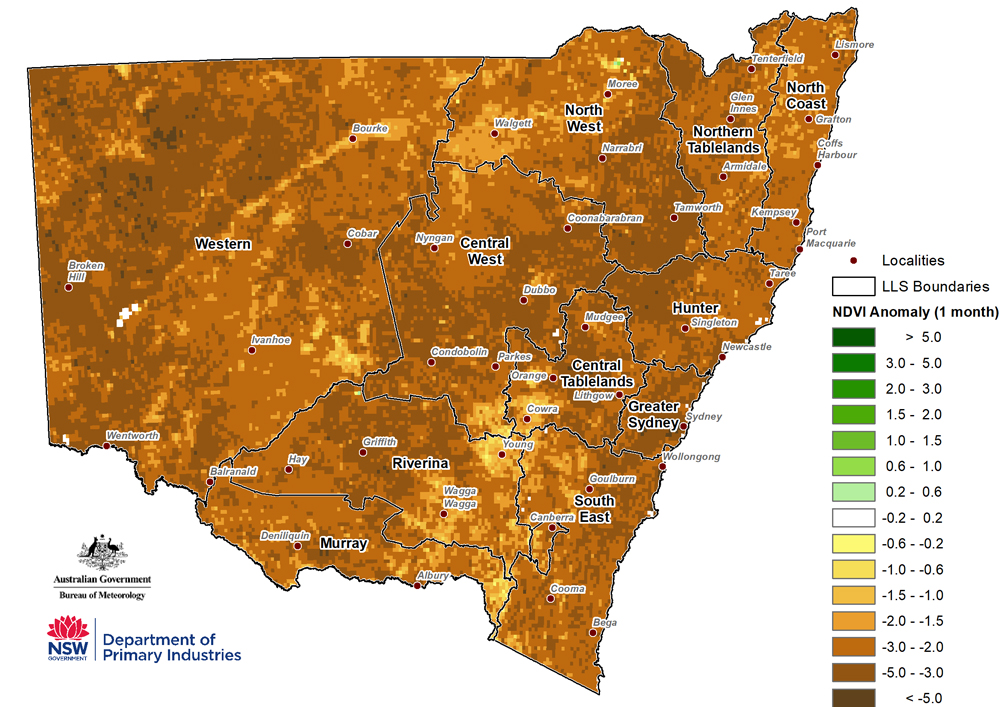
Temperature
Most of NSW experienced average daytime temperatures between 12-24°C (Figure 4). Temperatures Parts of Central Tablelands, Hunter and Northern Tablelands recorded average daytime temperatures between 6-12°C and alpine regions recording daytime temperatures between 0-9°C. Overnight temperatures range between 0-9°C across NSW, with alpine regions recording average overnight temperatures between -6-0°C (Figure 5).
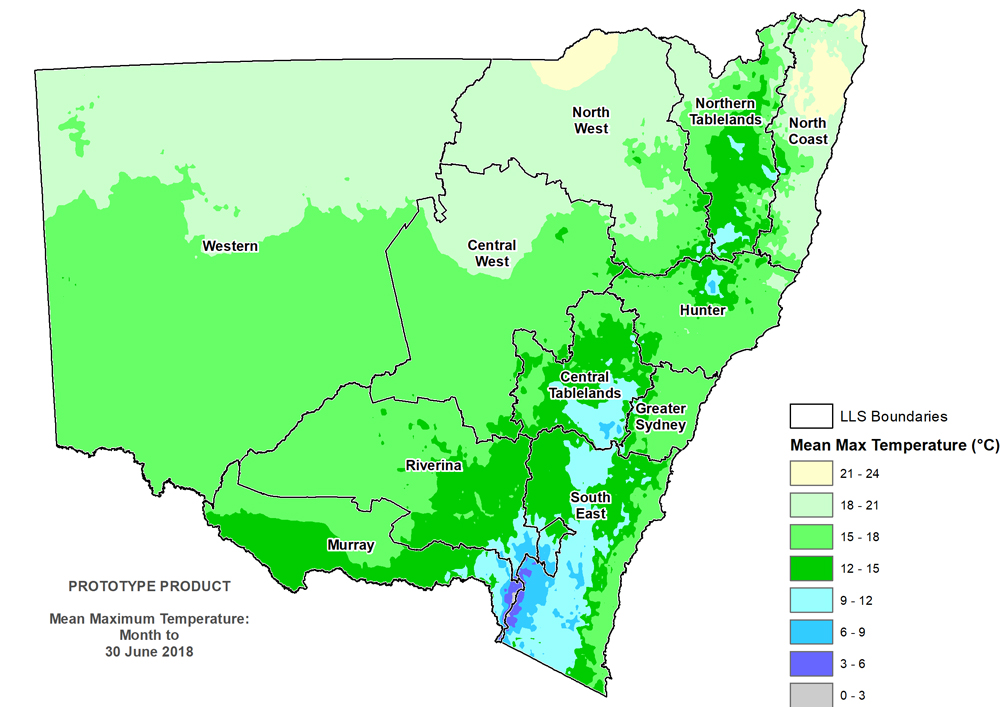
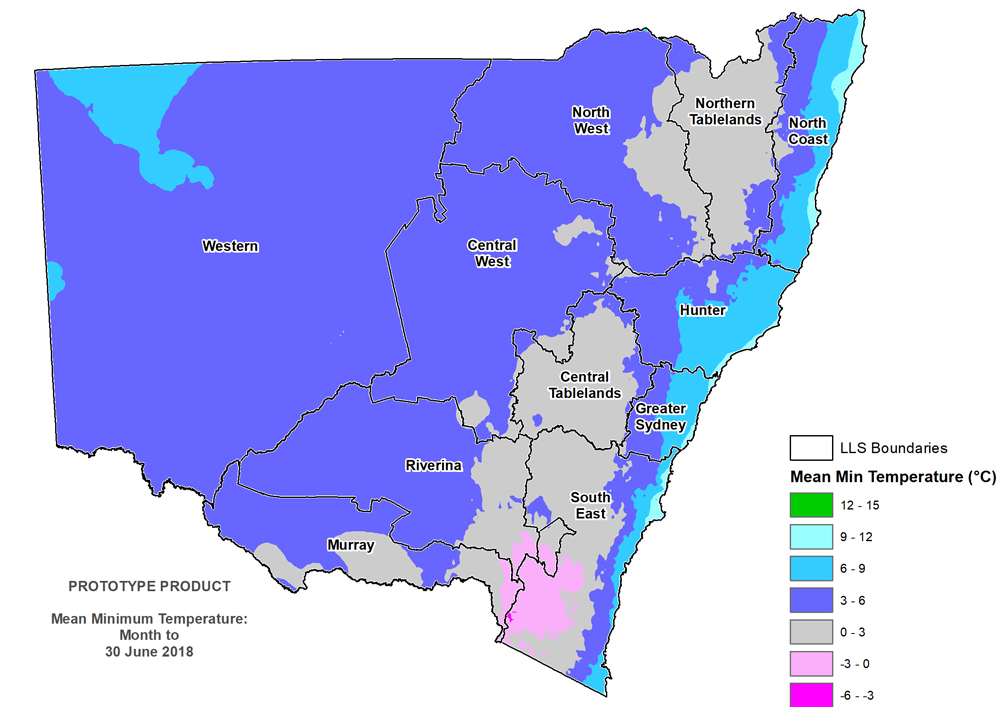
Extreme events
A cold front passed across the state in mid-June bringing extremely cold conditions and snow falls down to 700m in the Tablelands and alpine zones of NSW. This lead to stock alerts being issued for these parts of the state, with increased risk to sheep and cattle.
Rainfall Index
The Rainfall Index (RI, Figure 6) shows a large proportion of NSW experiencing below average to extremely low rainfall. There are some isolated parts of Western, North Coast, coastal Hunter and Central West Local Land Services regions with average rainfall, along with areas in Riverina, Murray and Western parts of South East LLS regions.
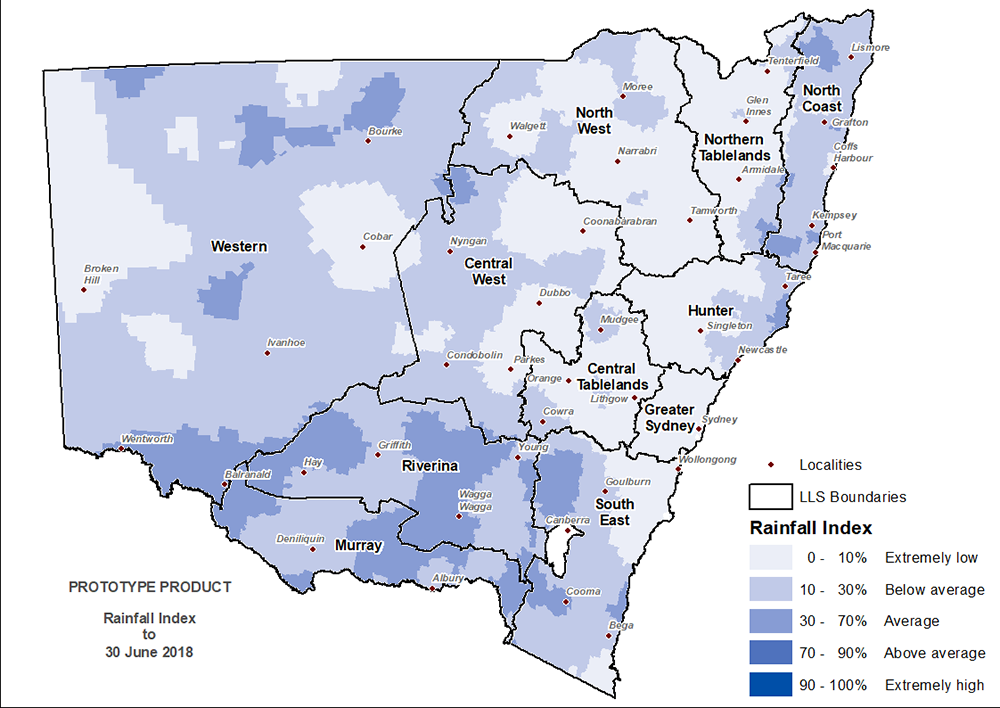
Soil Water Index
The Soil Water Index (SWI, Figure 7) shows that stored soil moisture is below average to extremely low across NSW. The extent of extremely low soil moisture reflects the on-ground conditions that have been reported to NSW over the last few months.
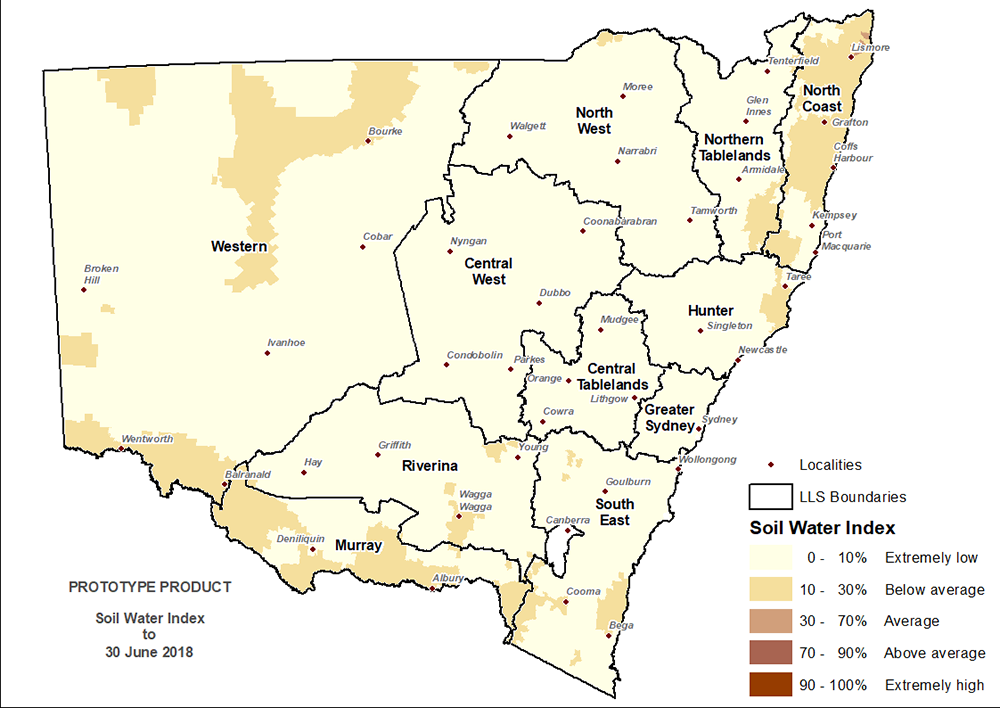
Plant Growth Index
The Plant Growth Index (PGI, Figure 8) is below average to extremely low across NSW and largely mirrors a deteriorating Soil Water Index (SWI). The low SWI and PGI levels are indicative of an agronomic drought, as currently being experienced across NSW.
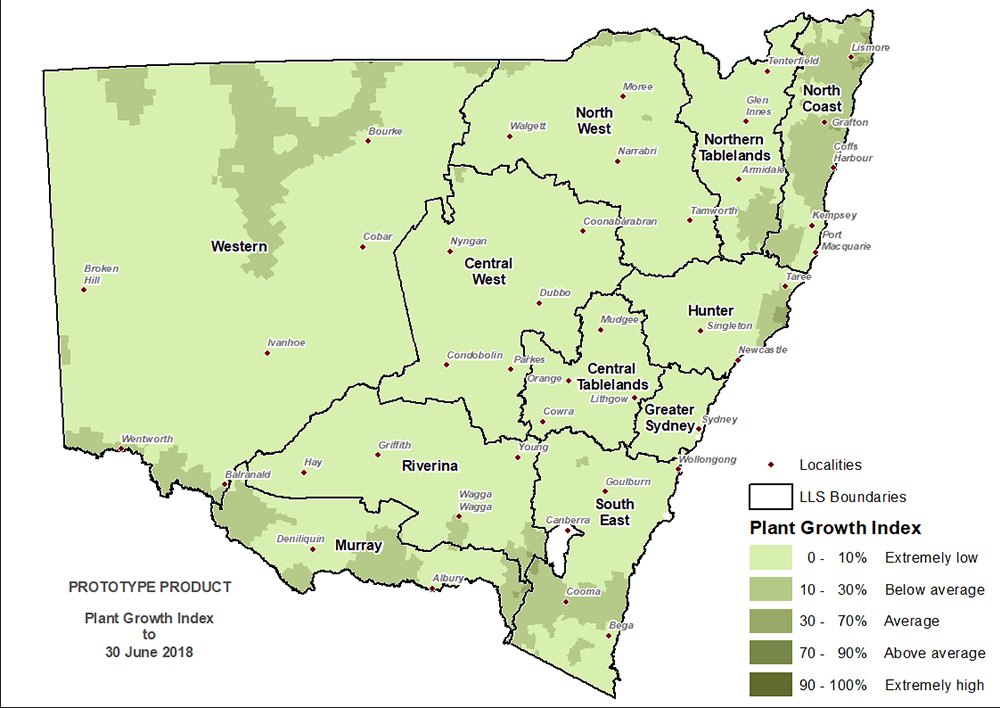
Drought Direction Index
Much of southern and western areas of NSW experienced enough rainfall over the last 200 days to place the Drought Direction Index (DDI, Figure 9) in a positive trend. This extends through the Central West, Riverina, Murray and Western LLS regions, given the substantive rainfall event in June. Importantly this does not constitute an end to the drought event in these regions and follow up rainfall is required to support a substantive recovery.
Elsewhere the DDI remains negative particularly in the North West, Northern Tablelands and North Coast Local Land Services regions, highlighting the intensification of the drought event in the north of the state.
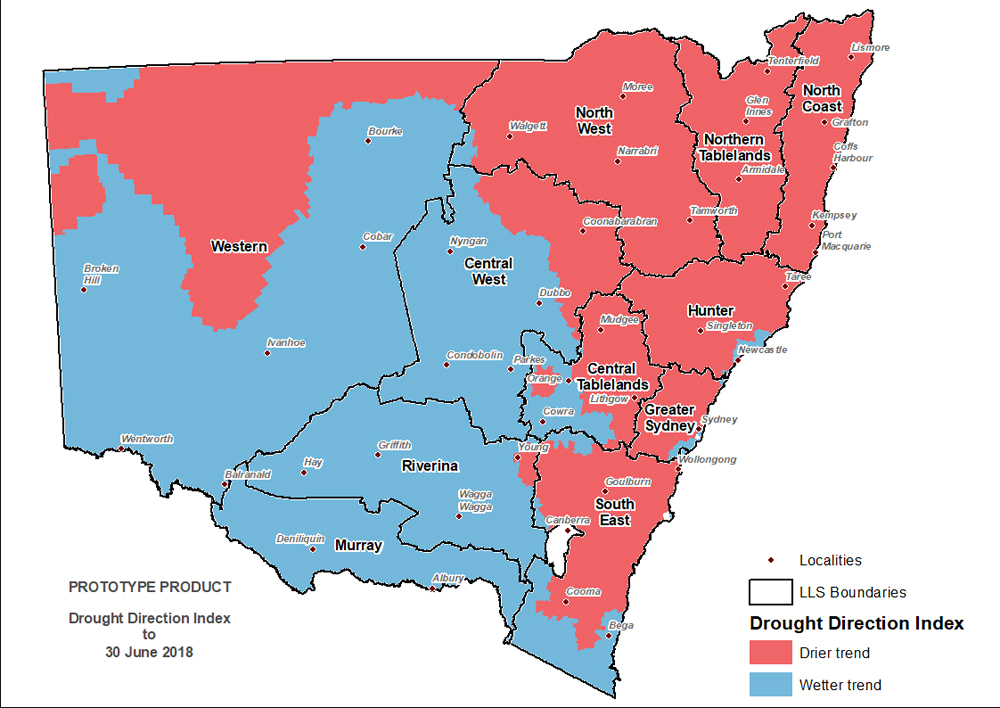
Changes in the individual drought indicators may have occurred since this update was released. For the most current information, please visit DroughtHub.
CDI status for the regions
Figure 10 displays the CDI status for each individual Local Land Services region to 30 June 2018.
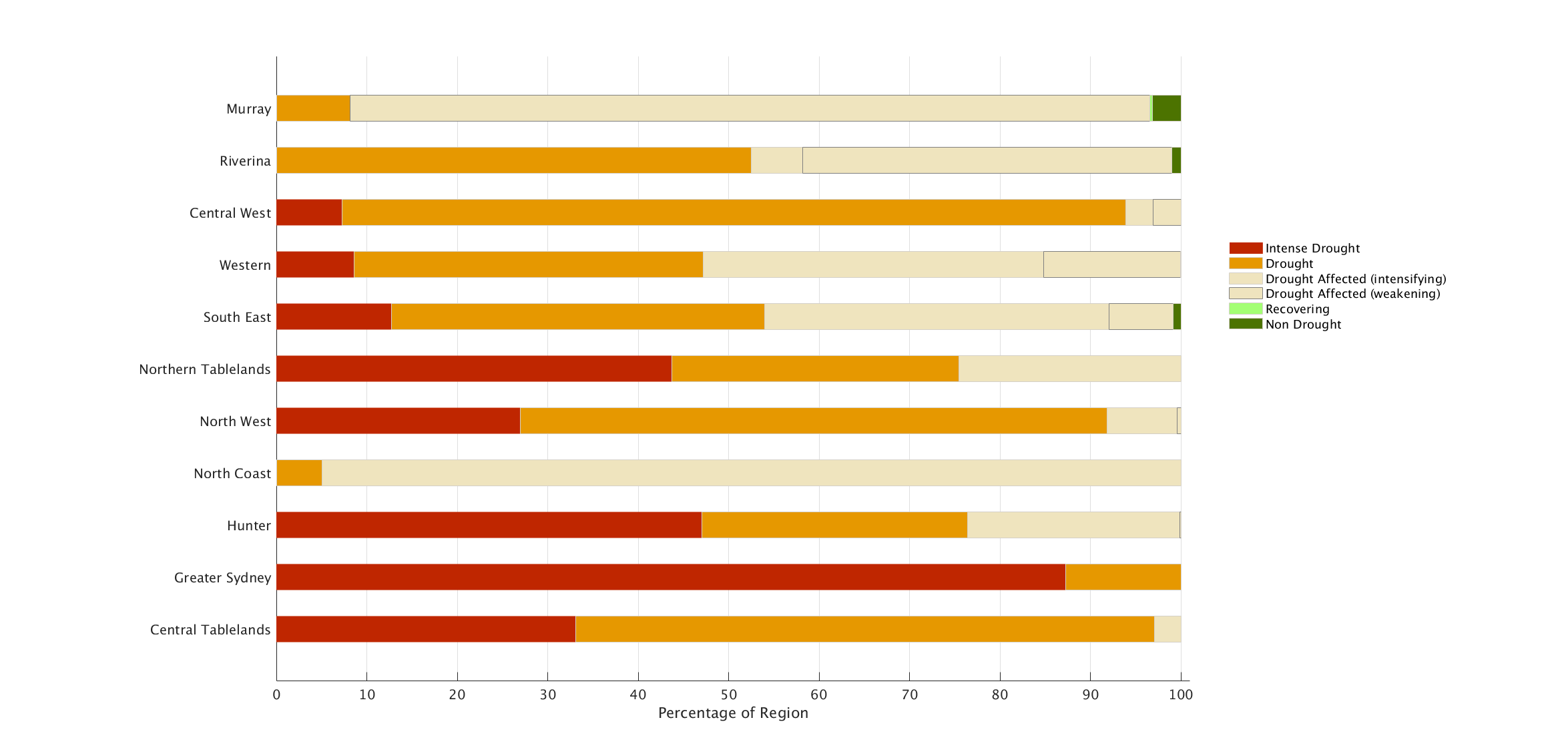
Murray and Riverina regions
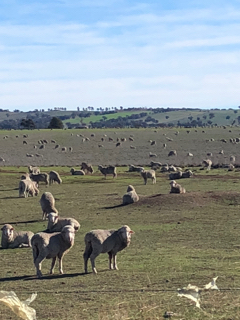
The eastern and southern Murray and Riverina Local Land Services (LLS) region have experienced rainfall, with conditions supporting late sowing opportunities, successful germination of crops as well as pasture growth in June. This has been aided by warmer soil temperatures extending into the winter. While this has provided an improvement in production it does not constitute a sustained recovery from drought and the region largely remains Drought Affected (to 30 June 2018; Figure 11). Soil water in these areas remains low with emerging crops relying on within season rainfall for further growth.
Much of the western Riverina LLS region remains in Drought, and has not experienced the more favourable production opportunities experienced in the east and south.
The poor conditions in the Murray and Riverina LLS regions have been driven by poor soil moisture and pasture/plant growth. Although there have been on-ground reports measuring some pasture growth (green pick) in the region, including areas around Wagga Wagga, Cootamundra and Young, conditions are still at critical levels.
The monthly NDVI anomaly (Figure 12) indicates that the entire regions has experienced below normal levels of greenness for the month, and slightly improved levels of greenness around Young, Cootamundra and Wagga Wagga reflect the on-ground conditions that have been reported to NSW DPI this month.
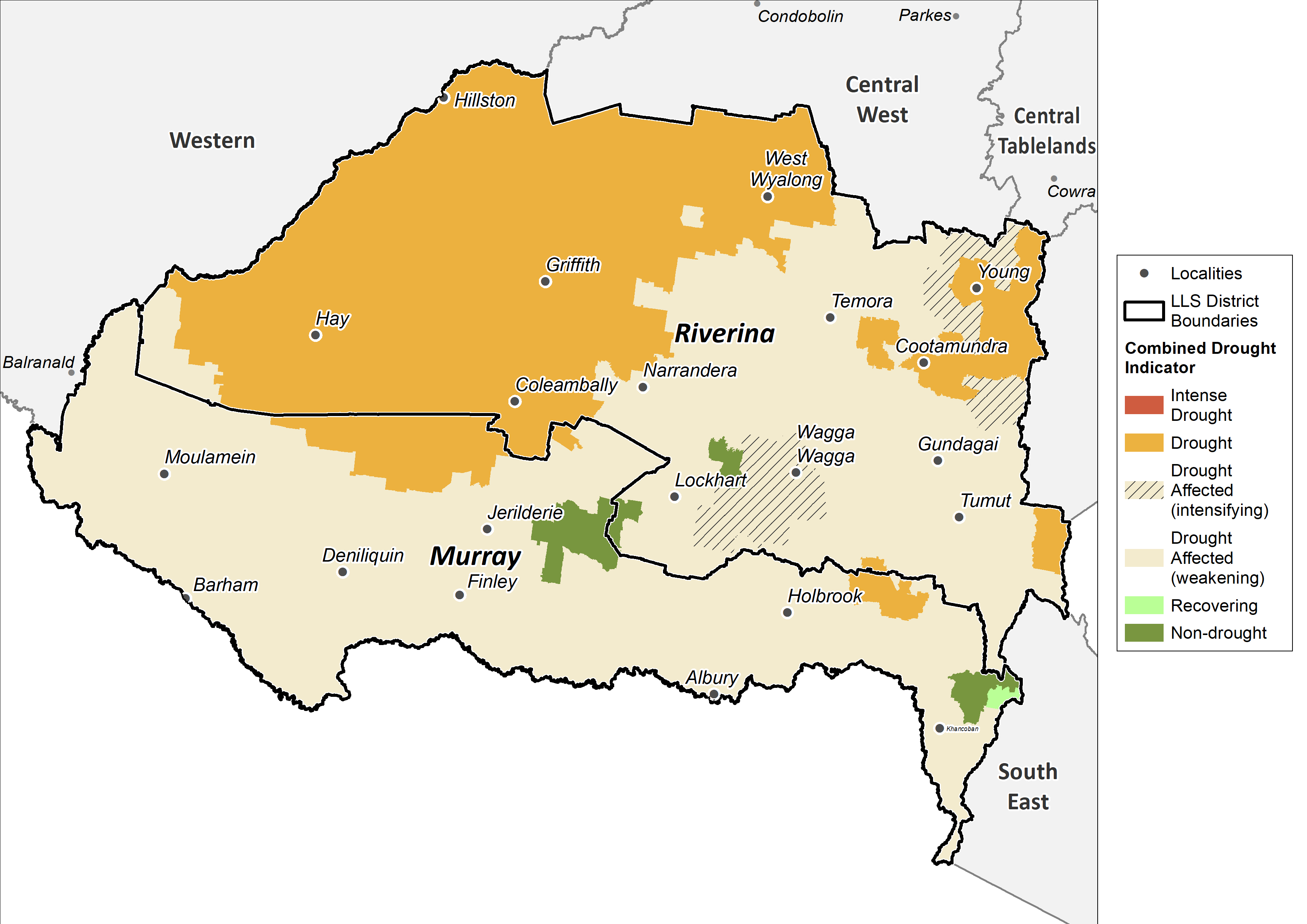
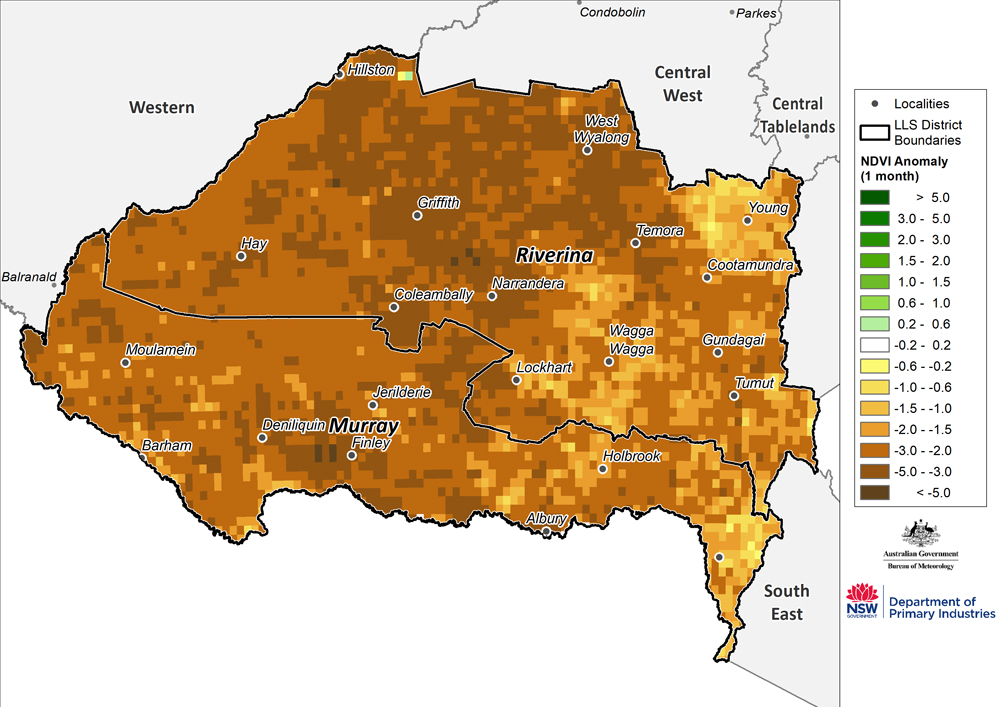
Western region
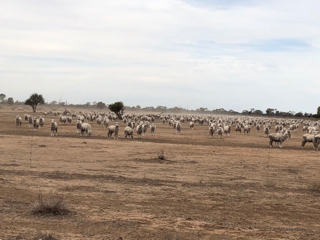
Drought conditions continue across the Western Local Land Services (LLS) region. The Combined Drought Indicator (to 30 June 2018; Figure 13) establishes that the entire region is experiencing drought conditions. Although parts of the region transitioned out of the more severe Intense Drought category during June (around Brewarrina, south of Menindee and west of Condobolin), the entire LLS region is still considered to be in drought. Closer inspection of the data shows that this transition out of Intense Drought and into Drought has been driven by the Rainfall Index, and the agronomic indices of plant growth and soil water continue to be at or close to historical lows.
The monthly NDVI anomaly (Figure 14) indicates that the entire regions has experienced below normal levels of greenness for the month and this reflects on-ground conditions that have been reported to NSW DPI during June. An important consideration in the Western LLS region is the impact of total grazing pressure on field conditions. When the agronomic indicators are at low levels it is likely that emergent forage could be consumed quickly, leading to very low groundcover and increased erosion risk.
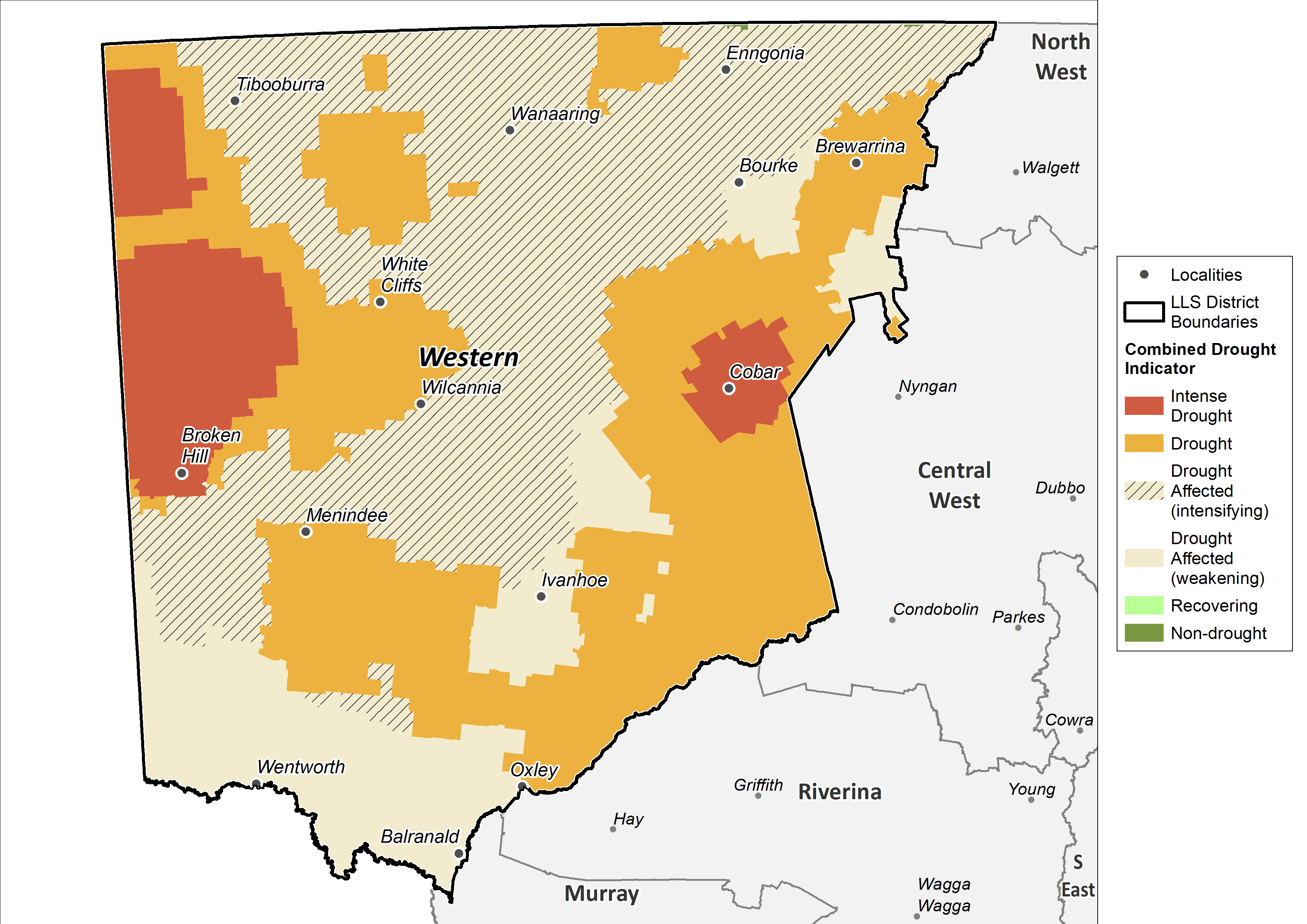
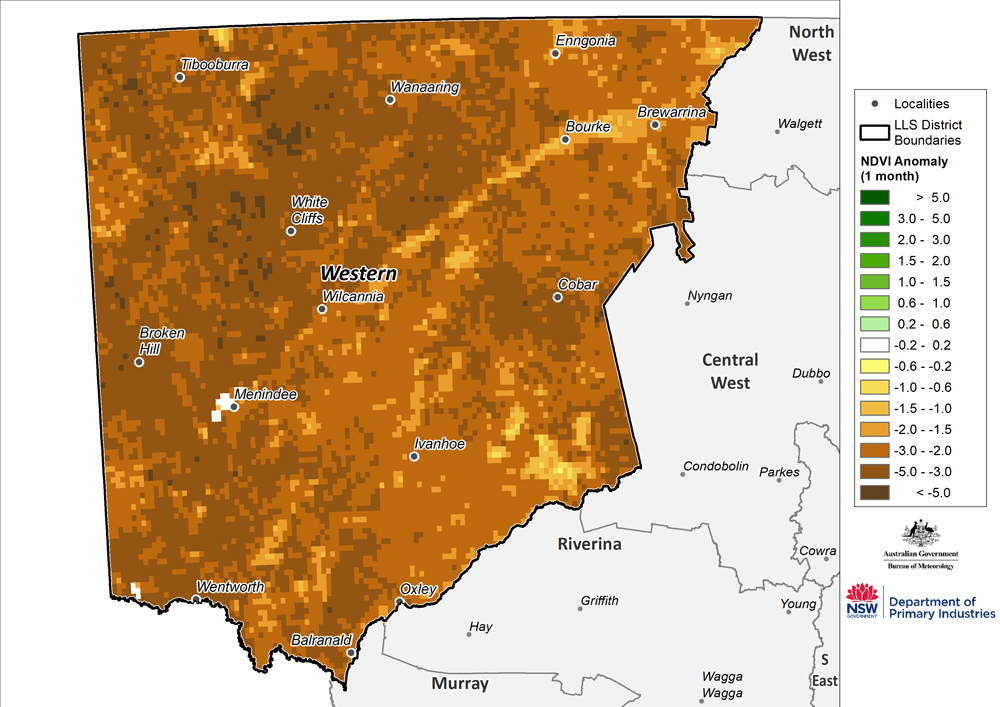
North West, Northern Tablelands and North Coast regions
Conditions in the North West, Northern Tablelands and North Coast Local Land Services regions have rapidly deteriorated during June with the entire area in one of the three drought categories. The Combined Drought Indicator (to 30 June 2018; Figure 15) establishes that the extent of Intense Drought, the most severe drought category, has expanded into large areas of North West and Northern Tablelands LLS regions. This is a continuation of a drought event the DPI has been monitoring since October 2017.
The area in Drought has also expanded in these two LLS regions, and closer inspection of the data shows that the indicator values are very close to Intense Drought category thresholds. Without decent rainfall in the coming weeks, DPI expects the extent of Intense Drought in these regions to expand.
The northern parts of North Coast LLS region has deteriorated rapidly during June and areas that were in Non-Drought have now transitioned into Drought Affected. DPI continues to monitor the situation in these LLS regions as conditions continue to deteriorate.
The monthly NDVI anomaly (Figure 16) indicates that the entire regions has experienced below normal levels of greenness for the month and this reflects on-ground conditions that have been reported to NSW DPI during June.
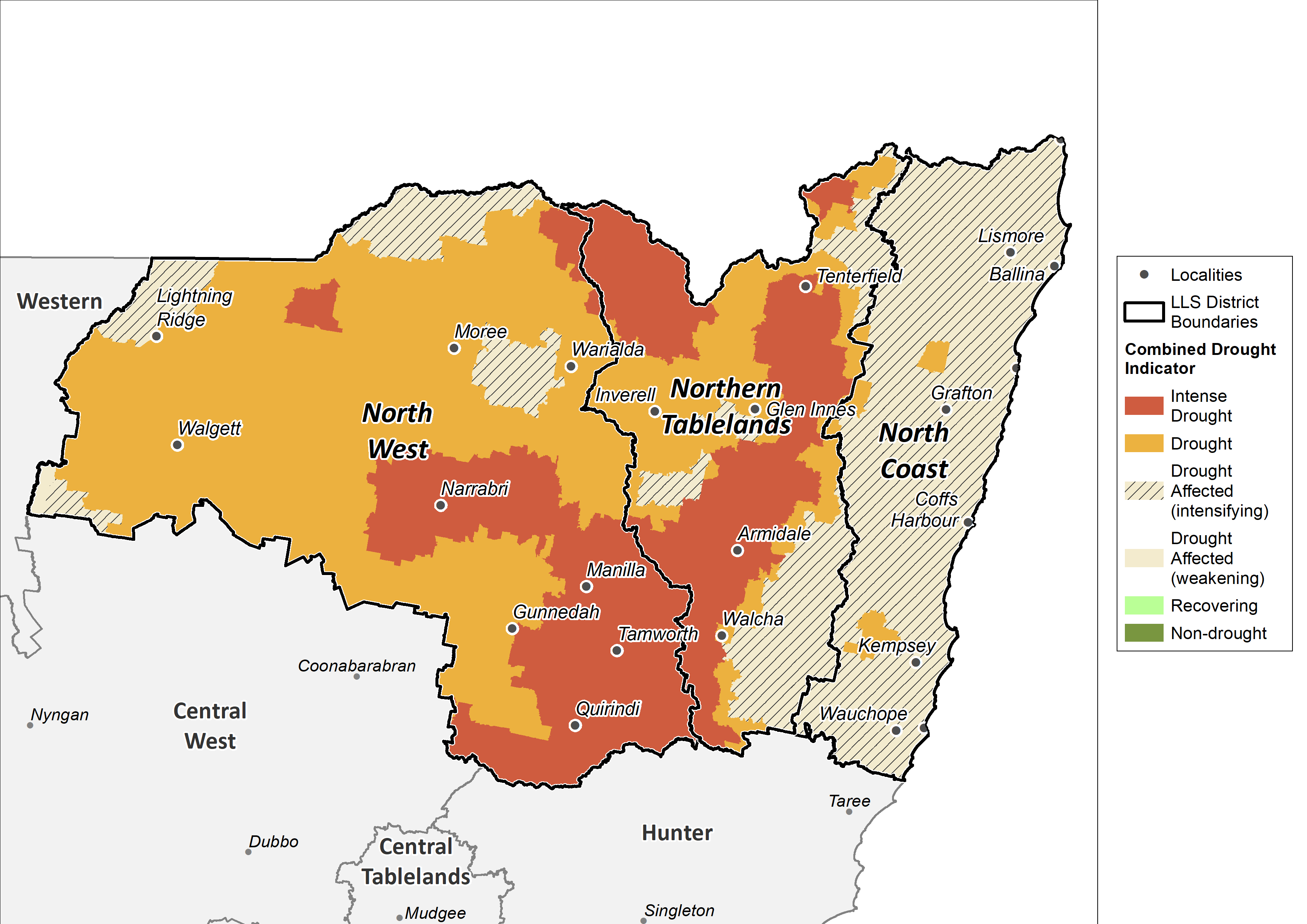
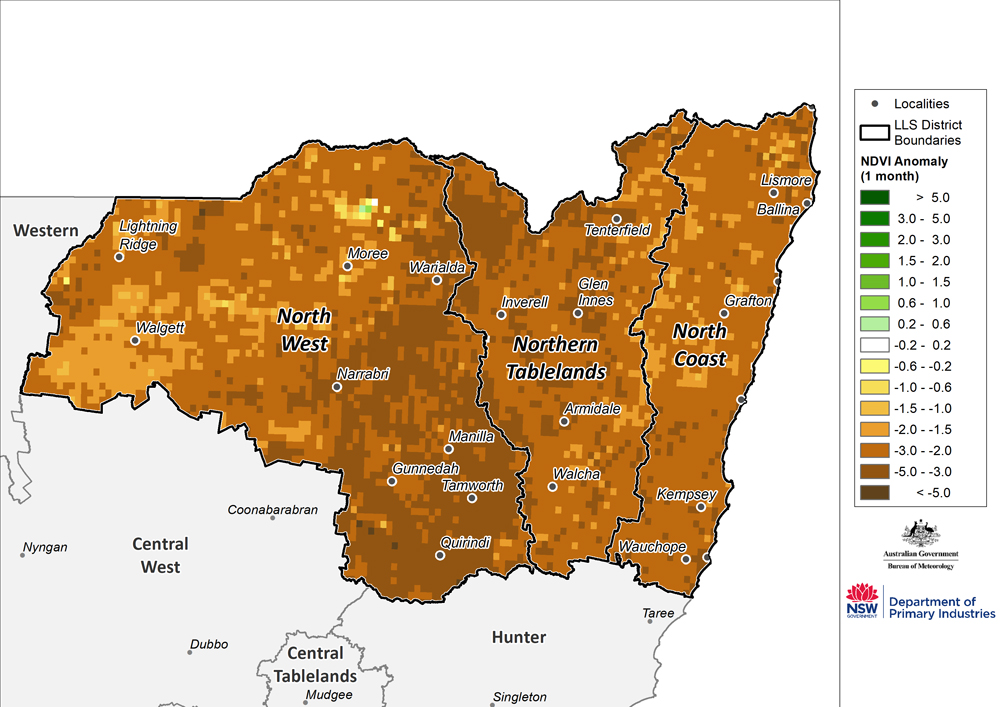
Central Tablelands, Central West, Hunter and Greater Sydney regions
Drought conditions continue across the Central Tablelands, Central West, Hunter and Greater Sydney Local Land Services (LLS) regions. The Combined Drought Indicator (to 30 June 2018; Figure 17) places the majority of the region in the Drought or Intense Drought categories. There has been a slight improvement in conditions in the Central West and Central Tablelands as parts of the regions transitioned out of Intense Drought and into Drought. The change in drought categories does not constitute an end to the drought event that DPI has been monitoring since October 2017. The shift in drought categories has been triggered by isolated falls of rain during mid and late June. DPI continues to monitor the situation as without follow up rain, many parts of the region will transition back into the Intense Drought category.
Importantly higher altitude regions in the Tablelands will not experience recovery in pasture conditions until spring 2018, even if substantive rainfall occurs over the coming winter months. This is because cold temperatures are limiting pasture production.
The area in Intense Drought continued to expand in the Greater Sydney LLS region during June and the area Drought Affected in the Hunter LLS region also expanded.
The monthly NDVI anomaly (Figure 18) indicates that the entire region has experienced below normal levels of greenness for the month and this reflects on-ground conditions that have been reported to NSW DPI during June. Field conditions reported to NSW DPI in June highlight a greening response of pastures and sowing/germination opportunities in the Cowra and Young regions. The NDVI data concurs with these field reports, but also shows that the extent of the response is isolated to a small area in the south of the Central Tablelands and Central West LLS regions.
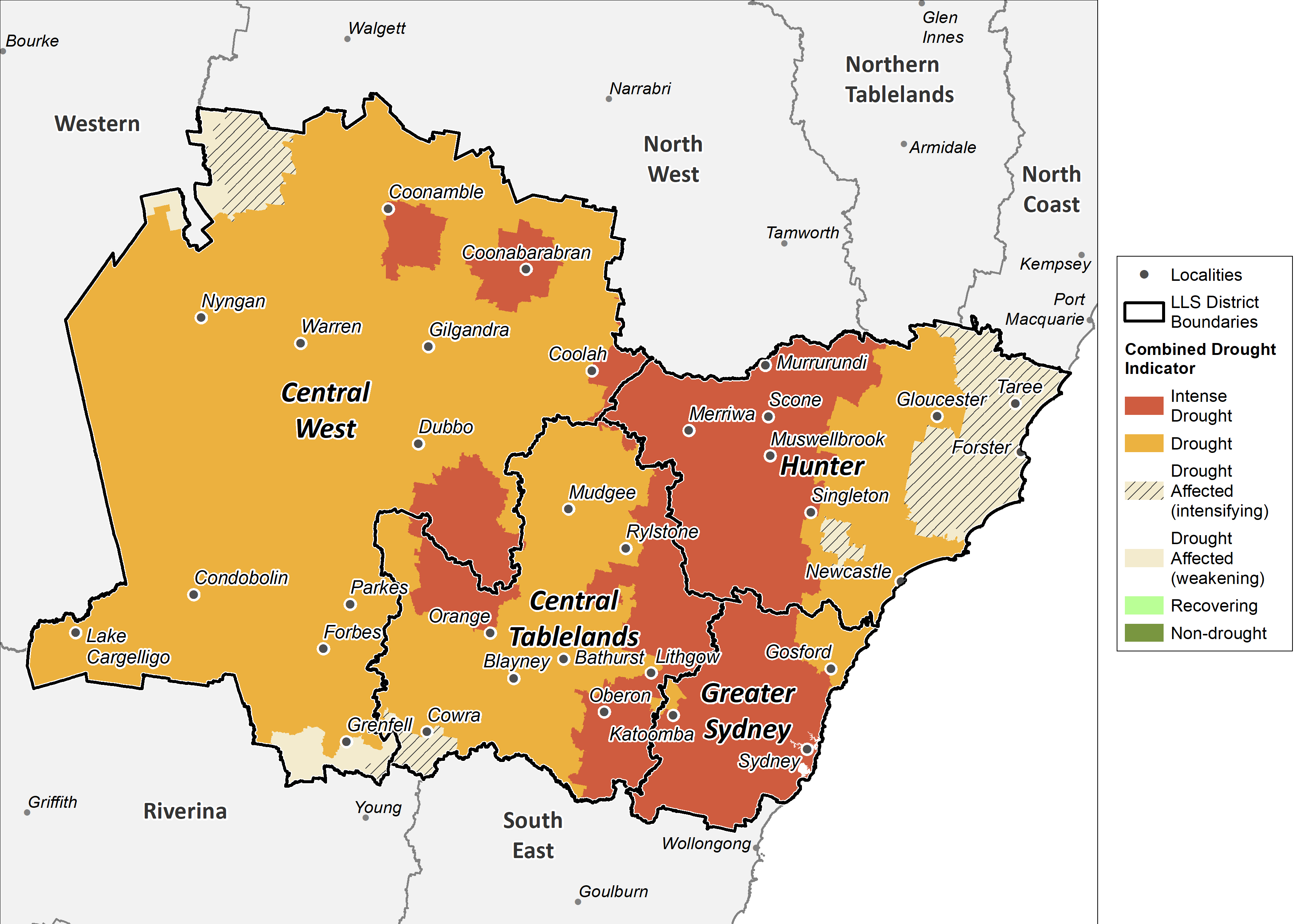
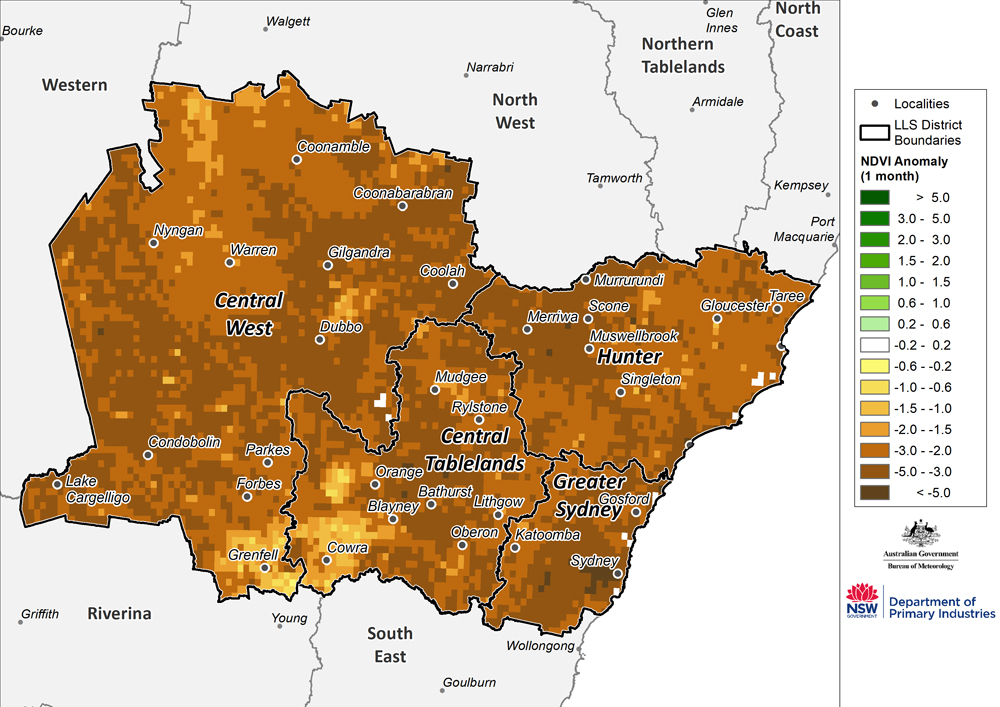
South East region
Drought conditions continue across the South East Local Land Services (LSS) region, although good rainfall and pasture recovery have been reported on the coastal fringe. The Combined Drought Indicator (to 30 June 2018; Figure 19) establishes that the majority of the region is experiencing drought conditions. The extent of Intense Drought has decreased, particularly in the far south east, which is now in the Drought category. There has been a slight improvement in conditions around Yass, due to isolated falls of rain. Agronomic indicators of plant growth and soil water remain near historic lows and the region as a whole is still experiencing drought conditions.
The monthly NDVI anomaly (Figure 20) indicates that the entire regions has experienced below normal levels of greenness for the month and this reflects on-ground conditions that have been reported to NSW DPI during June.
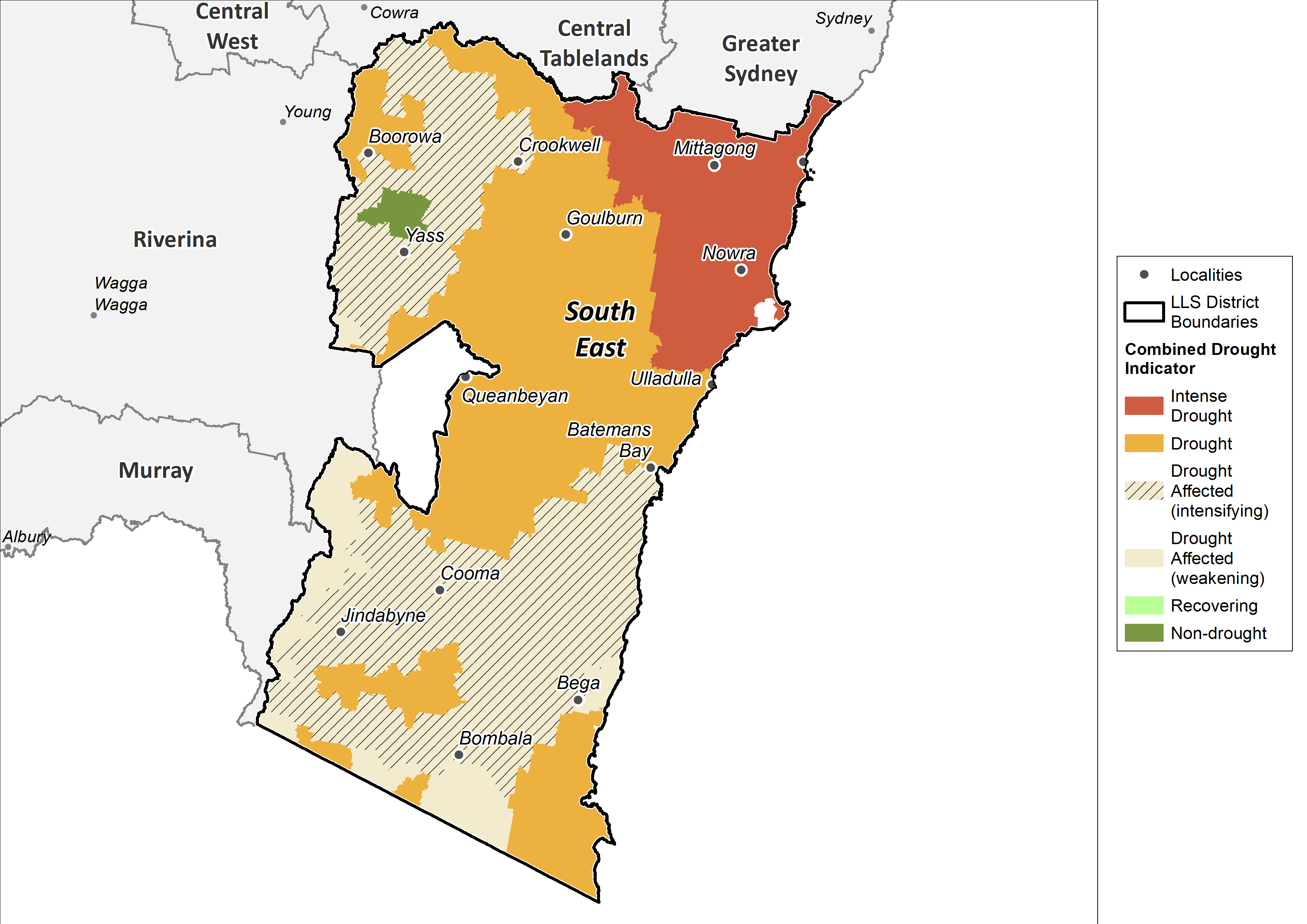
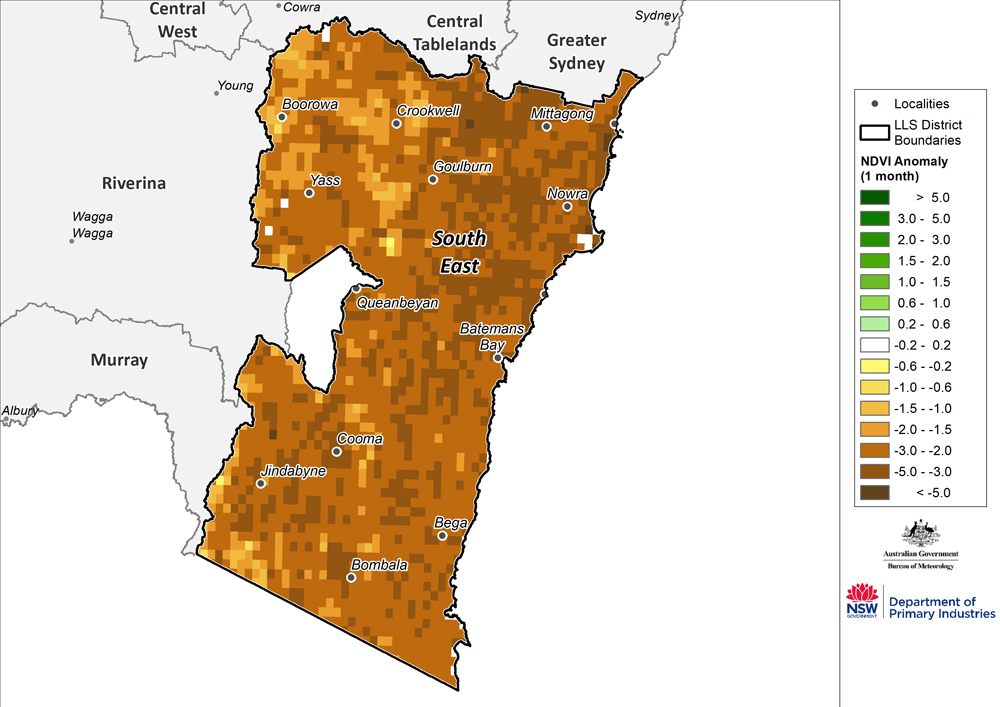
Official national outlook
The official national climate outlook for July to September was issued by the Bureau of Meteorology on 28 June 2018. The outlook shows that eastern and northern mainland Australia are likely to be drier than average while eastern parts of Tasmania are likely to be wetter than average. Elsewhere there are near-equal chances of a wetter or drier than average three months.
July to September daytime temperatures have an increased likelihood of being warmer than average across most of Australia, except for parts of far north Queensland and parts of Western Australia which have a near-equal chance of warmer or cooler than average conditions. Overnight temperatures have an increased likelihood of being warmer than average across Australia, except for parts of far north Queensland which have an increased chance of cooler than average overnight temperatures.
NSW outlook
For New South Wales, the rainfall outlook (Figure 21) for July to September indicates that there is an increased chance of drier than normal conditions across the majority of the state, except in the far south east which has a near-equal chance of a wetter or drier than average three months. The majority of NSW has between a 20 to 40% chance of exceeding median rainfall.
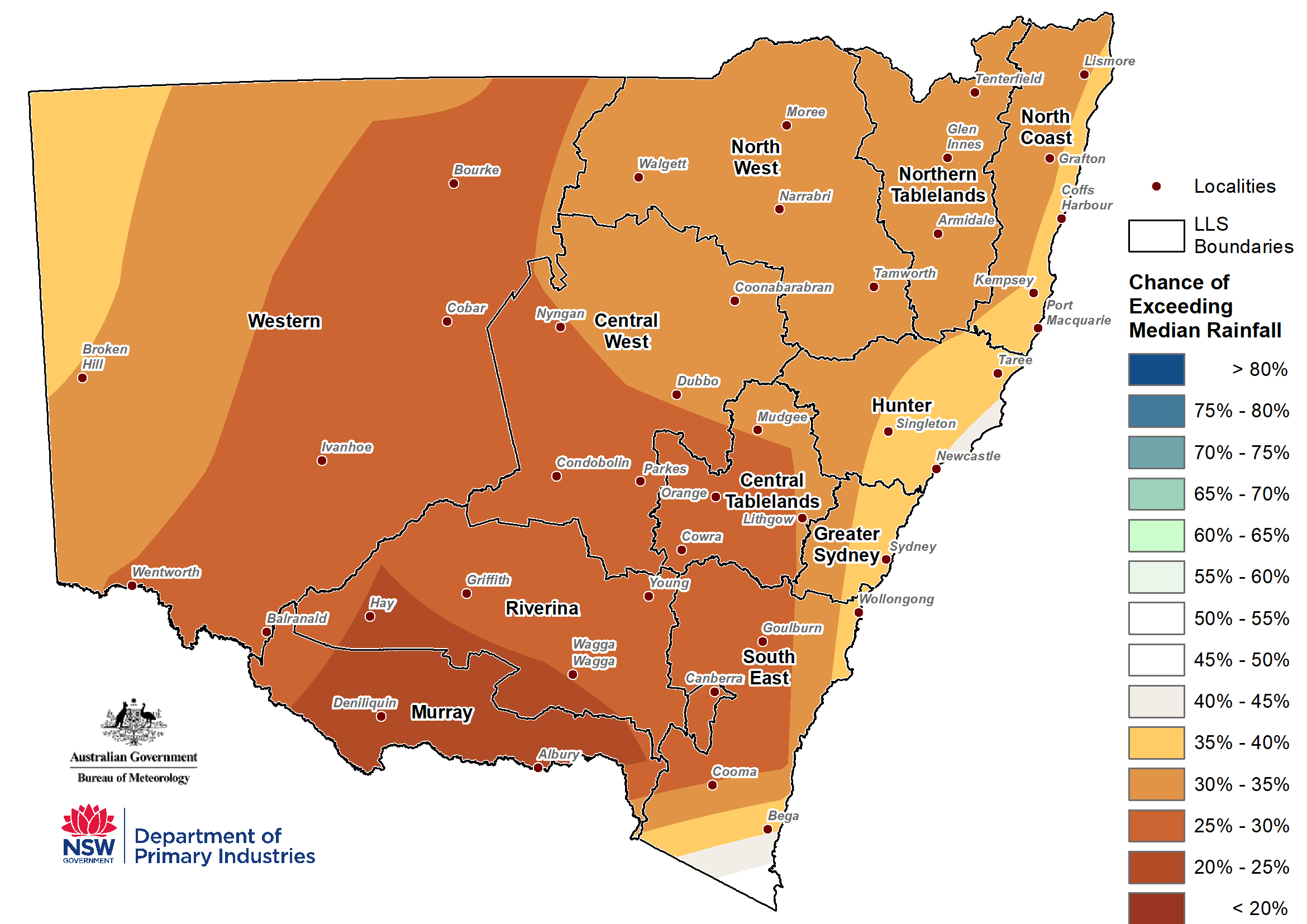
The temperature outlook (Figure 22 & Figure 23) indicates that there is an increased chance of warmer than average daytime temperatures across NSW. Overnight temperatures also have an increased likelihood of being warmer than normal across NSW, particularly along the coast.
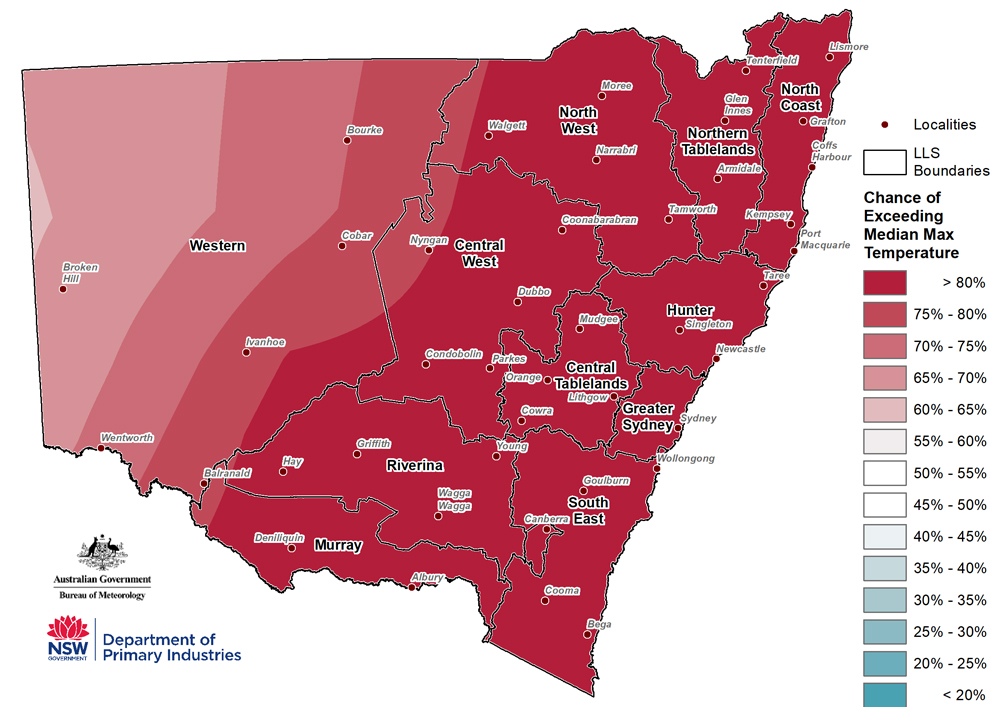
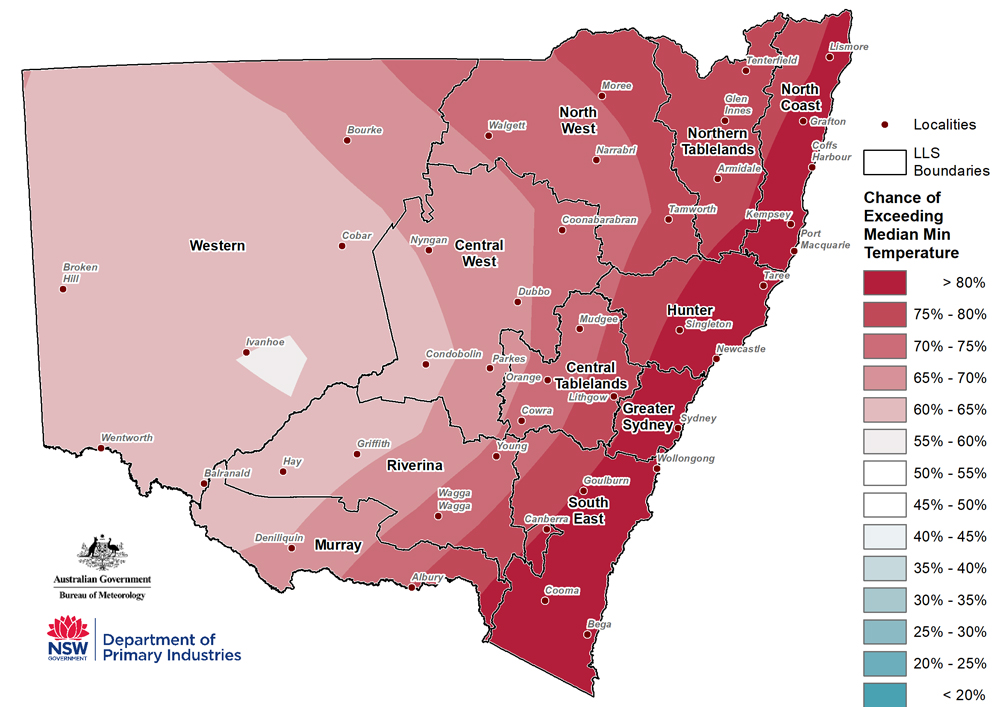
Overall, global climate models favour a near-neutral outlook for rainfall for NSW during July to September, with 1 model suggesting a wetter than normal outlook. They are generally neutral with four models exhibiting warmer than normal and two models suggesting cooler than normal conditions (Table 1).
Model Ensemble
Table 1: Overall NSW outlook – number of major climate models in each general category (as at 2 July 2018)
Rainfall | Generally wetter | Generally near-neutral | Generally drier | |
July - September | 1 | 10 | 2 | |
Temperature | Generally warmer | Generally near-neutral | Generally cooler | |
July - September | 4 | 7 | 2 |
Climate drivers
ENSO
The El Niño Southern Oscillation (ENSO) remains neutral (as of 3 July 2018), however some ENSO indicators show early signs of El Niño development. Sea surface temperatures in the central to eastern tropical Pacific Ocean remain neutral, but have been warming since April. Subsurface temperatures are also anomalously warm: a common warming sign of an impending El Niño. Most of the international climate models surveyed by the Bureau of Meteorology suggest that further tropical Pacific warming is likely, with five of the eight models indicating that El Niño conditions will be achieved in the southern hemisphere spring.
The Bureau of Meteorology’s Outlook is currently at El Niño WATCH, with a 50% chance of an El Niño forming in spring. During an El Niño, rainfall in eastern Australia is typically below average during spring and daytime temperatures in southern Australia are typically warmer than average.
Southern Oscillation Index and other indicators
The 30-day SOI value (Figure 24) is currently within the neutral range (30-day value was -5.5 as of 30 June 2018).
Cloud levels at the junction of the equator and the International Date Line have generally been below average since February. Trade winds are currently near average across much of the equatorial Pacific (as at 1 July).
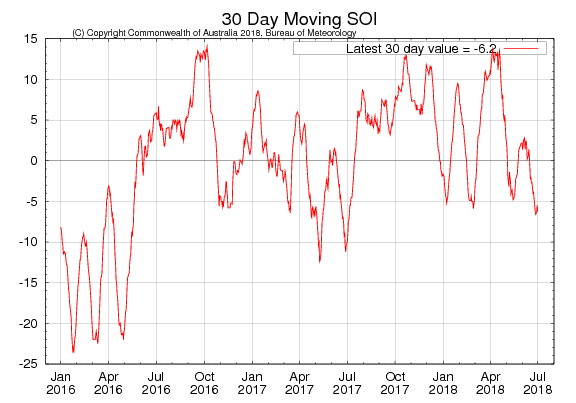
Sea surface temperatures
Monthly sea surface temperatures anomalies (SST) for June (Figure 25) were slightly warmer across the equatorial Pacific although remains within the Bureau of Meteorology’s neutral range (between -0.8 and +0.8 in the NINO3 and NINO3.4 regions. Anomalously warm sea surface temperatures are affecting a large area of the South Pacific and Tasman Sea.
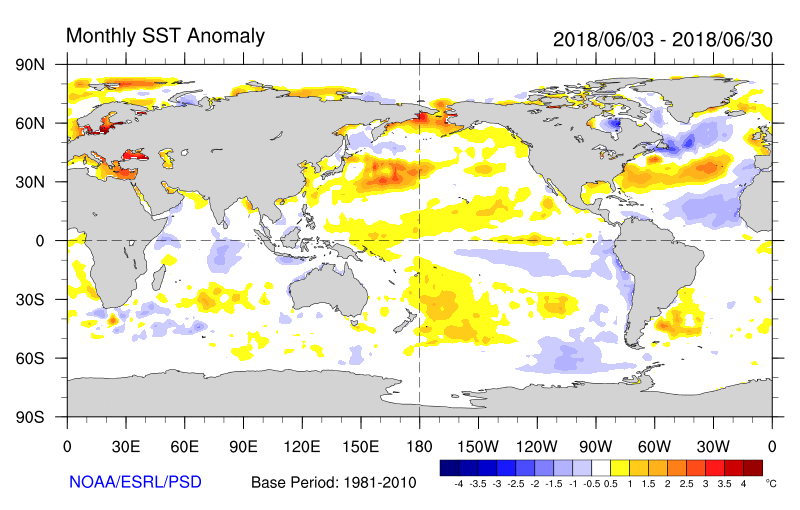
Sea Sub-surface Temperatures
Sub-surface temperatures as of 1 July 2018 show a pool of anomalously warm water extending across the top 150m of the equatorial Pacific. Though the magnitude of the anomaly has decreased slightly, the strongest warm anomalies continue to propagate eastward (Figure 26).
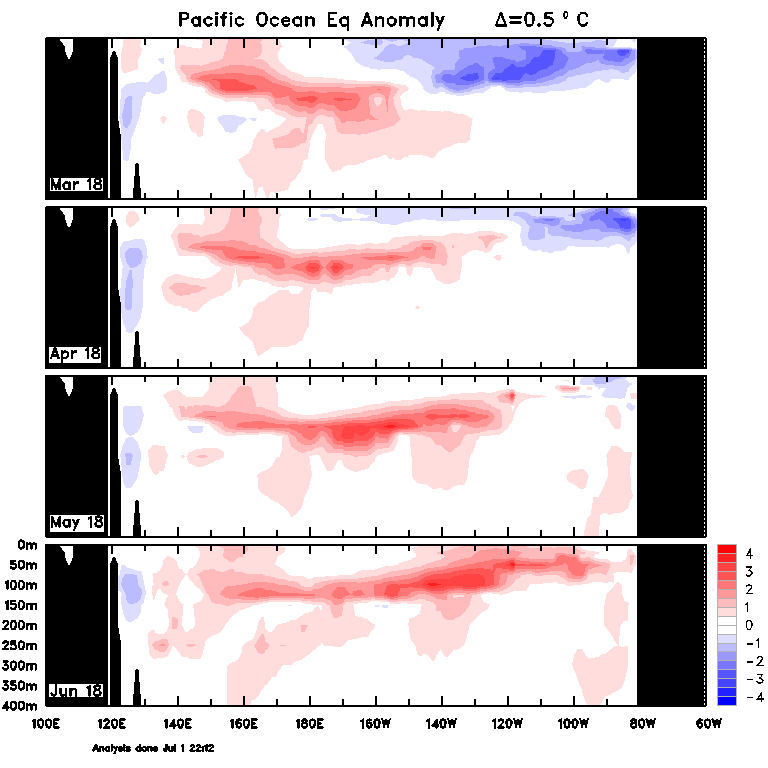
Indian Ocean
The Indian Ocean Dipole (IOD) remains neutral (as of 3 July 2018). All six international climate models surveyed by BoM predict that IOD is likely to remain neutral through southern hemisphere spring.
Southern Ocean
The Southern Annular Mode (SAM) is currently at near neutral (as of 28 June 2018).
How does it work?
Much of the information in the Seasonal Conditions Report is sourced from the NSW DPI Enhanced Drought Information System (EDIS) ™. The EDIS system is currently available in prototype form and is subject to an intensive ground truthing process. For more information, visit the interactive website via DroughtHub.
EDIS is an ongoing project aimed at improving the quality and timeliness of efforts to monitor conditions across the state. Key features of the system are:
- It tracks drought by using four indicators; rainfall, soil water, plant growth, as well as tracing rainfall trends. Agronomic conditions have equal value to rainfall recorded at meteorological stations.
- The Combined Drought Indicator (CDI) brings this information together, and has been designed to characterise developing drought conditions. The key purpose for building the CDI was as a drought early warning system.
- The rainfall, soil moisture and plant growth indicators in EDIS account for conditions over a 12 month window. This provides a compromise between a highly sensitive indicator (e.g. six months) and a less sensitive indicator (e.g. 24 months).
- Climate and remote sensing data drive the information system at a high resolution, but the CDI is reported at a Parish level.
- Because of its configuration and purpose, there will be differences to the indicator used in the National Drought Monitoring Framework (the Australian Rainfall Deficiency Analyser) which relies on rainfall alone.
- The CDI has three drought categories that characterise NSW according to drought intensity as well as the main drivers of a drought event (meteorological, hydrological and agronomic). DPI considers areas Drought Affected to be experiencing a drought event.
- The Drought Affected category encompasses a wide range of conditions from the very early stages of drought entry through to a drought event becoming intense. This enables the drought monitoring system to detect a drought event early. It is also possible to stay in the Drought Affected category for some period of time.
More services from EDIS are scheduled for release over the coming months including a seasonal conditions self-reporting application.
The way in which the indicators are combined to form the CDI is described in Table 2 below.
Table 2: Description of the Combined Drought Indicator framework
CDI Phase | Technical definition | Description - typical field conditions |
|---|---|---|
Intense Drought | All three indicators (rainfall, soil water, plant growth) are below the 5th percentile | Ground cover is very low, soil moisture stores are exhausted and rainfall has been minimal over the past 6-12 months. |
Drought | At least one indicator is below the 5th percentile | Conditions may be very dry, or agronomic production is tight (low soil moisture or plant growth). It is possible to be in Drought when there has been some modest growth, or a few falls of rain. |
Drought Affected (intensifying) | At least one indicator is below the 30th percentile and the rainfall trend is negative over the past 90 days. | Conditions are deteriorating; production is beginning to get tighter. Ground cover may be modest, but growth is moderate to low for the time of year. When indicators are close to the Drought threshold drought conditions are severe. |
Drought Affected (weakening) | At least one indicator is below the 30th percentile and the rainfall trend is positive over the past 90 days. | Production conditions are getting tighter, but there have been some falls of rain over the past month. It is rare to enter the Recovering phase from the Non-Drought category; Usually there is a quick (1-2 week) transition into Drought Affected or Drought. When indicators are close to the Drought threshold drought conditions are severe. |
Recovering | All indicators are below the 50th percentile but above the 30th percentile | Production is occurring but would be considered ‘below average’. Full production recovery may not have occurred if this area has experienced drought conditions over the past six months. |
Non-drought | At least one indicator is above the 50th percentile. | Production is not limited by climatic conditions. |
The NSW State Seasonal Update is provided each month by the NSW DPI Climate Unit, which is part of the Livestock Systems Branch in DPI Agriculture.
Information used in this report was primarily sourced from the Australian Bureau of Meteorology, the US National Oceanic and Atmospheric Administration, the International Research Institute for Climate and Society (Columbia University) and NSW Department of Primary Industries.
Maps in this document contain data which is © Spatial Services – NSW Department of Finance, Services and Innovation (2018), Panorama Avenue, Bathurst 2795 and data which is © Commonwealth of Australia 2018, Australian Bureau of Meteorology, Melbourne. All rights reserved.
The seasonal outlooks presented in this report are obtained from the Australian Bureau of Meteorology and other sources (including World Meteorological Organisation Global Producing Centres). These outlooks are general statements about the likelihood (chance) of (for example) exceeding the median rainfall or minimum or maximum temperatures. Such probability outlooks should not be used as categorical or definitive forecasts, but should be regarded as tools to assist in risk management and decision making. Changes in seasonal outlooks may have occurred since this report was released. Outlook information was up to date as at 4 June 2018.
All climate and remote sensing input data is supplied to the Enhanced Drought Information System ™ under the Australian Creative Commons Licence (CCY 4.0) and is made available by the Terrestrial Ecosystem Research Network.
© State of New South Wales through the Department of Industry, Skills and Regional Development, 2018. You may copy, distribute and otherwise freely deal with this publication for any purpose, provided that you attribute the NSW Department of Primary Industries as the owner.
Disclaimer: The information contained in this publication is based on knowledge and understanding at the time of writing (July 2018). However, because of advances in knowledge, users are reminded of the need to ensure that information upon which they rely is up to date and to check currency of the information with the appropriate officer of the Department of Primary Industries or the user’s independent adviser.
Published by the NSW Department of Primary Industries. ISSN 2202-1795 (Online). Volume 6 Issue 5

